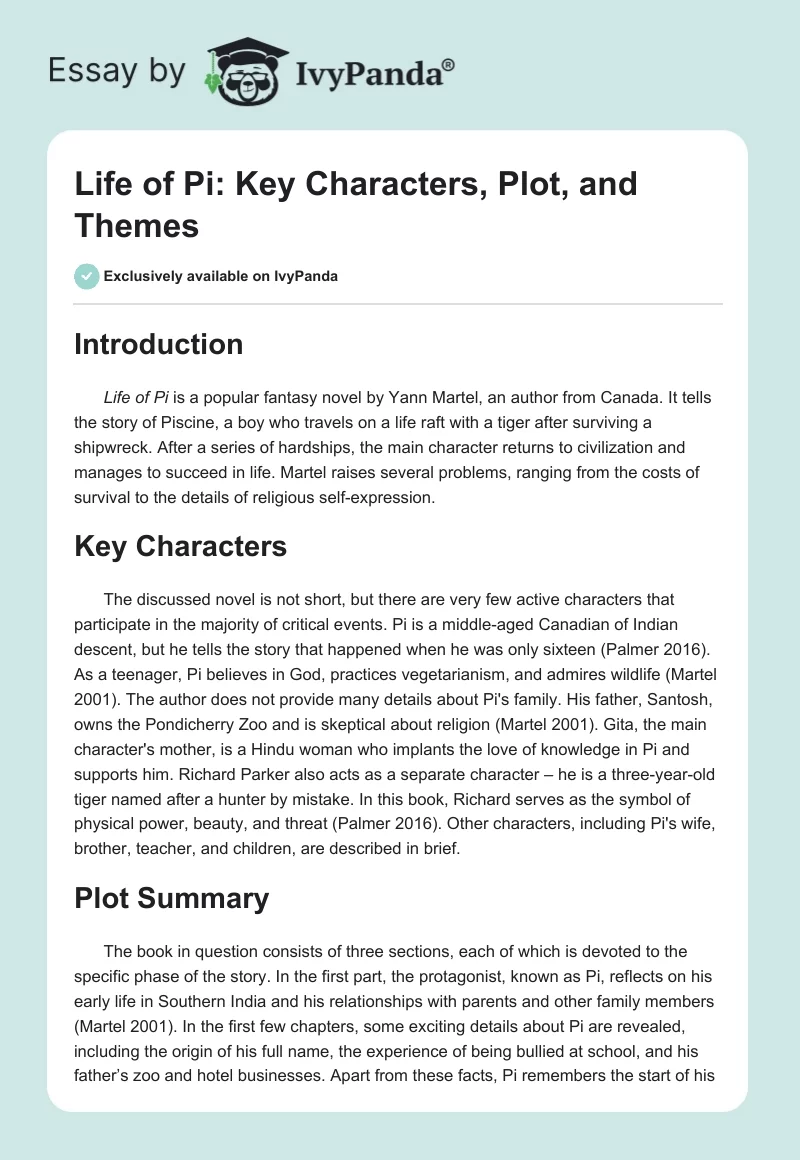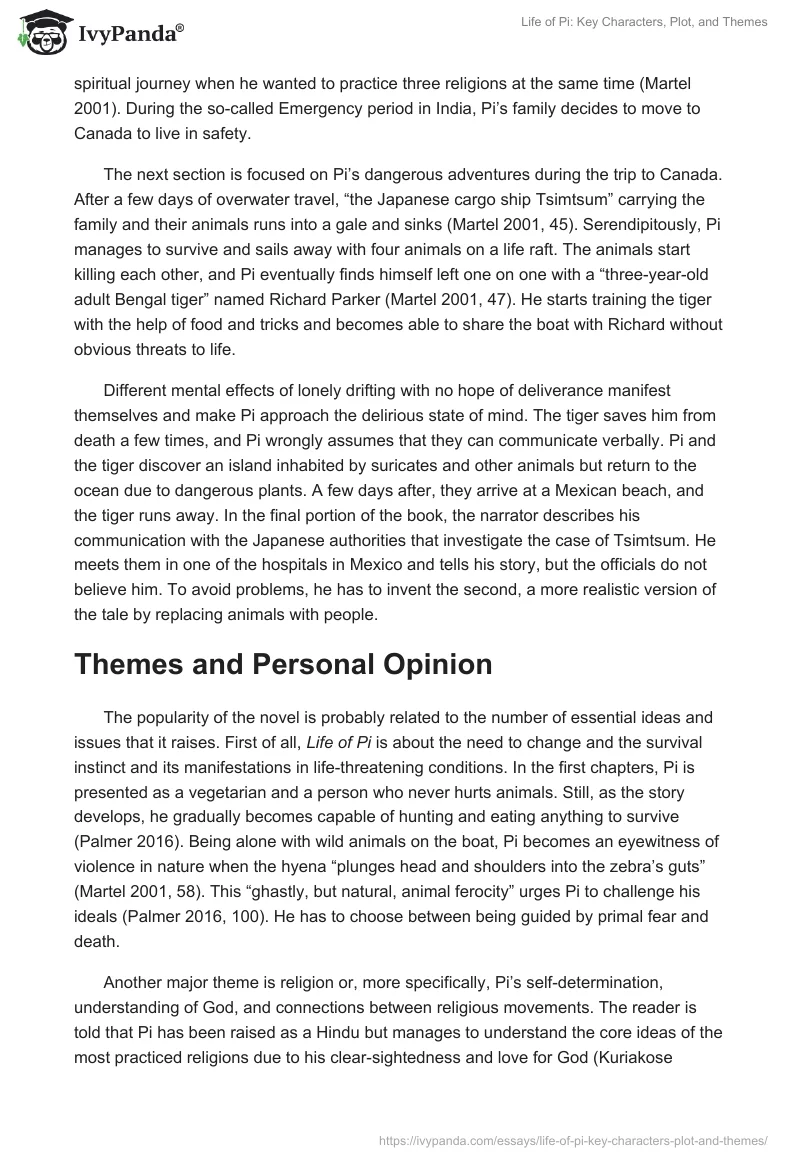Introduction
Life of Pi is a popular fantasy novel by Yann Martel, an author from Canada. It tells the story of Piscine, a boy who travels on a life raft with a tiger after surviving a shipwreck. After a series of hardships, the main character returns to civilization and manages to succeed in life. Martel raises several problems, ranging from the costs of survival to the details of religious self-expression.
Key Characters
The discussed novel is not short, but there are very few active characters that participate in the majority of critical events. Pi is a middle-aged Canadian of Indian descent, but he tells the story that happened when he was only sixteen (Palmer 2016). As a teenager, Pi believes in God, practices vegetarianism, and admires wildlife (Martel 2001). The author does not provide many details about Pi’s family. His father, Santosh, owns the Pondicherry Zoo and is skeptical about religion (Martel 2001). Gita, the main character’s mother, is a Hindu woman who implants the love of knowledge in Pi and supports him. Richard Parker also acts as a separate character – he is a three-year-old tiger named after a hunter by mistake. In this book, Richard serves as the symbol of physical power, beauty, and threat (Palmer 2016). Other characters, including Pi’s wife, brother, teacher, and children, are described in brief.
Plot Summary
The book in question consists of three sections, each of which is devoted to the specific phase of the story. In the first part, the protagonist, known as Pi, reflects on his early life in Southern India and his relationships with parents and other family members (Martel 2001). In the first few chapters, some exciting details about Pi are revealed, including the origin of his full name, the experience of being bullied at school, and his father’s zoo and hotel businesses. Apart from these facts, Pi remembers the start of his spiritual journey when he wanted to practice three religions at the same time (Martel 2001). During the so-called Emergency period in India, Pi’s family decides to move to Canada to live in safety.
The next section is focused on Pi’s dangerous adventures during the trip to Canada. After a few days of overwater travel, “the Japanese cargo ship Tsimtsum” carrying the family and their animals runs into a gale and sinks (Martel 2001, 45). Serendipitously, Pi manages to survive and sails away with four animals on a life raft. The animals start killing each other, and Pi eventually finds himself left one on one with a “three-year-old adult Bengal tiger” named Richard Parker (Martel 2001, 47). He starts training the tiger with the help of food and tricks and becomes able to share the boat with Richard without obvious threats to life.
Different mental effects of lonely drifting with no hope of deliverance manifest themselves and make Pi approach the delirious state of mind. The tiger saves him from death a few times, and Pi wrongly assumes that they can communicate verbally. Pi and the tiger discover an island inhabited by suricates and other animals but return to the ocean due to dangerous plants. A few days after, they arrive at a Mexican beach, and the tiger runs away. In the final portion of the book, the narrator describes his communication with the Japanese authorities that investigate the case of Tsimtsum. He meets them in one of the hospitals in Mexico and tells his story, but the officials do not believe him. To avoid problems, he has to invent the second, a more realistic version of the tale by replacing animals with people.
Themes and Personal Opinion
The popularity of the novel is probably related to the number of essential ideas and issues that it raises. First of all, Life of Pi is about the need to change and the survival instinct and its manifestations in life-threatening conditions. In the first chapters, Pi is presented as a vegetarian and a person who never hurts animals. Still, as the story develops, he gradually becomes capable of hunting and eating anything to survive (Palmer 2016). Being alone with wild animals on the boat, Pi becomes an eyewitness of violence in nature when the hyena “plunges head and shoulders into the zebra’s guts” (Martel 2001, 58). This “ghastly, but natural, animal ferocity” urges Pi to challenge his ideals (Palmer 2016, 100). He has to choose between being guided by primal fear and death.
Another major theme is religion or, more specifically, Pi’s self-determination, understanding of God, and connections between religious movements. The reader is told that Pi has been raised as a Hindu but manages to understand the core ideas of the most practiced religions due to his clear-sightedness and love for God (Kuriakose 2018). Pi recognizes things that the adherents of Hinduism, Islam, and Christianity have in common, thus demonstrating his “religious imagination” (Wagner 2016, 1). He believes the concept of God to be universal and describes Hindus as “hairless Christians,” Muslims as “bearded Hindus,” and Christians as “hat-wearing Muslims” (Martel 2001, 26).
In my opinion, the novel is unique since it makes totally different worlds coexist peacefully, and it does not refer only to religion. The author uses various writing techniques and proceeds from obviously fantastic scenes to naturalistic descriptions of what Pi observes during his long journey. To me, Life of Pi is among the books that can be understood in plenty of ways. It means that all people can learn more about themselves when going through a series of unexpected adversities with Pi and trying to imagine what they would do if they were him. From my perspective, Life of Pi encourages individuals to value life just like other shipwreck narratives do. It also teaches the readers that finding their inner strength in critical situations may require revising their views of life.
Personally, I am sure that the book also has a deep meaning when it comes to culture and religion. The author’s multicultural background enables him to make references to different traditions without raising conflicts (Kuriakose 2018). To some extent, the plot demonstrates that a person’s religious affiliation does not matter when his or her life hangs in the balance. From Pi’s inner dialogues, it becomes clear that religious rivalry stems from several artificial barriers between people. Conceivably, the book can make those believing in the superiority of their religion challenge their views, thus improving mutual understanding.
Conclusion
To sum it up, Martel’s novel raises many philosophical themes, including religious self-determination, God’s universality, and behavioral changes that people experience in the face of death. Being quite dynamic, the plot can be interpreted in a variety of ways and lead people to different conclusions. In my opinion, the book teaches the audience to build inner strength, value life, and avoid dividing people by religion.
References
Kuriakose, John. 2018. “Religious Pluralism in Yan Martel’s Life of Pi: A Case of Intertextual Correspondence with Swami Vivekananda’s Religious Philosophy.” Advances in Language and Literary Studies 9 (2): 138–145. Web.
Martel, Yann. 2001. Life of Pi. Toronto, Canada: Knopf Canada.
Palmer, Christopher. 2016. Castaway Tales: From Robinson Crusoe to Life of Pi. Middletown, NJ: Wesleyan University Press.
Wagner, Rachel. 2016. “Screening Belief: The Life of Pi, Computer Generated Imagery, and Religious Imagination.” Religions 7 (8): 1–22. Web.


